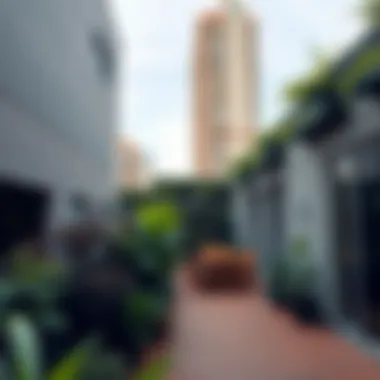Innovative Vertical Gardening in Urban Environments


Intro
In the hustle and bustle of urban life, where concrete jungles dominate the skyline, the concept of vertical gardening emerges as a refreshing breath of fresh air. This innovative approach offers a solution to many of the challenges faced by cities today, particularly in sprawling metropolises like Dubai. As more individuals look to create their own green oasis amid skyscrapers and busy streets, understanding the nuances of vertical gardening becomes imperative.
The practice not only serves aesthetic purposes but also plays a crucial role in enhancing the environmental quality of urban ecosystems. By integrating nature into vertical structures, architects and city planners are rethinking urban space design in ways that prioritize sustainability and well-being. Encouraging green roofs, living walls, and even entire vertical gardens can transform drab facades into vibrant living artworks while countering issues such as air pollution and urban heat.
As we unfold the layers of this practice, we will explore the various types of vertical gardens, delve into their benefits, and investigate their implications on urban life—from the greenery's positive psychological effects to the notable shifts in real estate trends.
Market Insights
Urban areas like Dubai are experiencing a remarkable renaissance in real estate development, particularly with the surging interest in sustainable and green practices. The push toward vertical gardening aligns seamlessly with the broader trends that dominate the market. As a city renowned for its luxury and innovation, Dubai is seeing an increased demand in investments for properties that integrate green technologies.
Current Trends in Dubai Real Estate
The integration of vertical gardens has changed how residents and investors view urban properties:
- Eco-Friendly Initiatives: More developments are highlighting their green credentials, which appeal to eco-conscious investors.
- Urbanization: The rapid growth of urban centers necessitates creative solutions for space optimization, hence the rise of vertical gardening.
- Community Engagement: Developers are focusing on creating communities centered around nature, promoting an active lifestyle.
This burgeoning trend is not merely a fad but indicates a long-term commitment to integrating green spaces into urban designs. Local real estate markets may soon adapt to this shift, offering properties that boast not just luxury, but also environmental responsibility.
Predictive Analysis of Future Developments
Investors keen on Dubai's real estate should keep a sharp eye on these upcoming trends:
- Increased ROI: Properties incorporating vertical gardens are expected to yield higher returns as buyers prioritize eco-friendly solutions.
- Sustainability Standards: With regulation likely changing, properties will need to meet stricter environmental standards, surfacing new opportunities for businesses that incorporate sustainable designs into their construction.
- Long-Term Value: Homes or buildings with green features may maintain or even increase their value better than those without.
"As cities expand, particularly in desert regions like Dubai, vertical gardening presents itself as a pragmatic solution to sustain urban biodiversity."
In summation, vertical gardening isn't just about beautifying the cityscape; it represents a significant shift in the way people perceive living spaces in urban contexts, especially in places striving to be at the pinnacle of modernity and sustainability.
[Source:
- Wikipedia on Vertical Gardening
- Britannica on Urban Gardening
- Reddit on Urban Green Spaces
- US Government on Urban Green Initiatives ]
Prolusion to Vertical Gardening
In the pressing reality of urbanization, one can’t help but notice the increasing concrete jungle swallowing the vibrant greenery of our surroundings. Vertical gardening presents a lively solution to this issue, one that reintroduces nature into our bustling lives. As cities expand and land becomes scarce, this innovative approach allows us to redefine our limitations, ushering in a new realm of possibilities for integrating greenery in our everyday environments.
Definition and Concept
Vertical gardening refers to the method of cultivating plants in a vertical space, rather than the conventional horizontal garden. This technique can involve various structures such as walls, planters, or even entire frameworks designed for plant growth. Think of a vertical garden as your friend who always finds a way to make the most out of a small room — they use the stairwell and every nook to present their collection of potted herbs, cascading flowers, or perhaps even vegetables that delight and sustain.
It’s not merely about aesthetics or decor; vertical gardening sets the stage for urban biodiversity, enhances air quality, and engages communities.
Historical Context
While vertical gardening appears to be a novel trend tied to modern environmental consciousness, its origins stretch back centuries. Ancient civilizations, such as the Hanging Gardens of Babylon, celebrated vertical cultivation long before the term gained traction. Furthermore, practices resembling vertical gardening, like the use of trellises, exist in traditional agriculture. Fast forward to the 20th century, and we start witnessing the advent of living walls and green roofs, both creating a stir in urban development.
In recent years, urban architects and planners have increasingly embraced these practices, evidenced in iconic projects like Bosco Verticale in Milan. Such projects indicate not just a shift in agricultural practices but a recalibration in how we perceive our living spaces and their relationship to nature.
Understanding this comprehensive swipe from historical roots to modern adaptations provides invaluable context, ultimately revealing that vertical gardening is not just a passing fad but rather a flourishing idea with deep-seated significance.
The Necessity of Vertical Gardening
Vertical gardening is more than just a trendy way to spruce up a wall; it’s a crucial response to the challenges posed by urban living. As cities grow, space is becoming more of a luxury than a common good. Vertical gardening provides a solution that not only utilizes space efficiently but also contributes positively to our environment. In this section, we'll discuss the necessity of vertical gardening, focusing on the issues of urbanization and its environmental impact.
Urbanization and Limited Space
With urban development accelerating at breakneck speed, high-rise buildings have become the norm, leaving little ground space available for gardening or even green areas. The sprawl of concrete, steel, and asphalt can stifle nature, creating what feels like a drab environment. The practical answer to this problem lies in vertical gardening, which allows urban dwellers to indulge in greenery without requiring expansive plots of land.
The implementation of vertical gardens can transform rigid urban structures into living, breathing entities. These gardens can be attached to balconies, walls, and rooftops, turning previously underutilized areas into vibrant green spaces. For those living in apartment complexes or densely populated neighborhoods, vertical gardening is often the only way to cultivate plants, flowers, or even vegetables. If one can have a small miracle of nature just outside their window, it's a big plus.
Moreover, vertical gardens can serve as community projects, fostering a sense of togetherness among residents. When people come together to design and maintain a shared vertical garden, they not only enhance their living environment but also build relationships that contribute to community spirit. The importance of ongoing green initiatives cannot be understated as they plant roots not only in the soil but in people’s hearts, creating a lasting impact.
Environmental Impact
The environmental benefits of vertical gardening are manifold and cannot be overlooked. First, these gardens can help combat the urban heat island effect. Cities often experience higher temperatures than surrounding rural areas due to the concentration of human activity, infrastructure, and limited vegetation. By installing vertical gardens, buildings can maintain lower temperatures, thereby reducing reliance on air conditioning and conserving energy.
In addition, vertical gardens act as natural air filters. They absorb carbon dioxide and produce oxygen, aiding in improving urban air quality which, let’s be honest, often leaves much to be desired. Plants also play a role in the management of rainwater runoff; they absorb rainwater, reducing the risk of flooding and erosion while ensuring better water retention in the soil.


Furthermore, the incorporation of diverse plant species in urban environments promotes biodiversity. By creating habitats on building facades and rooftops, vertical gardens encourage the presence of birds, bees, and butterflies, which are all key players in the ecosystem. This biodiversity is essential for pollination processes and maintaining a balanced urban ecosystem, directly linking back to human well-being.
In summary, vertical gardening addresses the pressing issues of urbanization and its negative environmental impact. This innovative approach not only revitalizes physical spaces, but also enhances community ties, improves air quality, and promotes biodiversity, making it an indispensable solution for modern cities.
Types of Vertical Gardens
Vertical gardening presents a unique opportunity for maximizing green space in urban environments. Understanding the types of vertical gardens is essential, as each form serves specific needs and comes with its own set of advantages and challenges.
Green Walls
Green walls are akin to living paintings, integrating plants into vertical structures that can be part of a building's facade. These installations not only beautify urban landscapes but also play a role in improving air quality and reducing noise pollution. While they're visually stunning, installing a green wall requires careful planning regarding plant selection and irrigation.
The designs can vary from expansive walls that stretch across entire buildings to smaller installations suitable for residential spaces. They can incorporate a variety of plant types—from vines to small shrubs—depending on the desired aesthetic and environmental factors.
One of the prominent examples of a green wall is the Museo del Chocolate, located in Barcelona. This wall serves not just as an art piece but also as a functional biophilic component that softens the harsh concrete jungle.
Living Walls
Living walls, closely related to green walls, take the concept further. They often come with modular planting systems that allow for diversification in plant species and flexibility in layout. Unlike traditional gardening methods, living walls are designed for vertical growth, which can host small trees in addition to herbs and decorative plants.
They play a significant role in biodiversity enhancement, providing habitats for various urban wildlife. The choice of plants can include succulents and ferns, which are often preferred due to their low maintenance requirements.
For instance, the Edificio Insignia in Madrid features a stunning living wall that not only upgrades the building’s appearance but also contributes positively to its thermal insulation. In turn, this translates to lower energy costs.
Vertical Planters
Vertical planters are perhaps the most versatile among the types of vertical gardens. Ranging from simple DIY setups to sophisticated commercial options, vertical planters can be installed on balconies, walls, or freestanding structures. They are especially ideal for urban dwellers looking to cultivate herbs or small vegetables in limited space.
These planters come in various shapes and sizes, allowing for maximized planting without sacrificing floor space. Homeowners can easily adapt them to their preferences, opting for arrangements that complement their home’s architectural style.
Moreover, vertical planters can foster a sense of community. For example, community gardens in urban neighborhoods often utilize vertical planters to engage residents in sustainable practices, promoting both social interaction and environmental stewardship.
In summary, the types of vertical gardens—green walls, living walls, and vertical planters—offer distinct advantages, catering to different preferences and environmental conditions. Each type can transform urban spaces by bringing nature closer to people, thus enriching city life and contributing to a healthier ecosystem.
Benefits of Vertical Gardening
The significance of vertical gardening cannot be overstated, especially in our urbanized world where green spaces are often scant. With rapid population growth and dense cityscapes, innovative solutions like vertical gardening present a way to integrate nature into our living environments. It’s not merely a trend; it’s a necessity that offers numerous advantages ranging from aesthetic to environmental impacts.
Aesthetic Enhancements
Vertical gardens do wonders in terms of beautifying urban landscapes. Imagine a drab concrete wall transformed into a lush tapestry of flora, bursting with colors and textures. These gardens don’t just make places look pretty; they also contribute significantly to the ambiance of city life. When you walk by a vibrant green wall, it can uplift your spirits in a way that stark buildings cannot.
Notably, vertical gardens allow architects and designers the freedom to create stunning visual effects. They can transform empty walls into art installations alive with plants. This creative approach means every urban site has potential for enhancement. Whether it’s a residential building or a commercial storefront, a vertical garden adds value—not just to the property, but to the neighborhood’s visual appeal as a whole.
Air Quality Improvement
Plants are nature’s own air purifiers. Vertical gardens, filled with an array of species, play a crucial role in improving urban air quality. They absorb carbon dioxide and release oxygen, which is vital in bustling cities where air pollution can be problematic. This natural filtration can lead to a noticeable decrease in airborne pollutants.
Additionally, the sheer surface area provided by vertical gardens helps capture dust, pollen, and particulate matter, thus mitigating respiratory issues often prevalent in urban areas. Studies suggest that deploying greenery in city infrastructures can cause significant improvements in air quality, potentially leading to healthier communities.
"The more we incorporate nature into urban life, the better our environment and our health can become."
Thermal Insulation
Vertical gardens can also be a boon for energy efficiency in buildings. They act as natural insulators that regulate temperature. In summer, these lush living walls can reduce indoor temperatures by providing shade and releasing moisture into the air, which cools the surrounding environment. In the winter, they serve as insulation to keep heat from escaping, potentially lowering heating costs.
This kind of sustainable approach not only saves money but also reduces the carbon footprint of buildings. By diminishing reliance on heating and cooling systems, vertical gardens contribute to a more energy-efficient urban lifestyle, making them increasingly attractive for homeowners and developers alike.
Design Principles for Vertical Gardens
Designing vertical gardens involves more than just slapping a few pots on a wall—there’s a method to the madness. Thoughtful planning enhances both the aesthetic and environmental benefits of these green masterpieces. When choosing to incorporate vertical gardens into urban settings, several key principles must be considered to ensure sustainability and visual impact.
Site Assessment
The first step in creating an effective vertical garden is a thorough site assessment. The location can make or break your greenery endeavor. Factors such as sunlight exposure, wind patterns, and even wall material play crucial roles. Ideally, assess your wall's orientation: is it south-facing and soaked in sun, or north-facing and shrouded in shade?
- Sun Exposure: Plants have different needs; some thrive in full sun while others prefer the cool shadows. Knowing how much natural light your vertical space receives informs plant selection.
- Microclimates: Urban areas have unique microclimates caused by structures and landscaping. These can influence temperature and humidity levels close to your growing space. This knowledge can help you select plants suitable for these specific conditions.
- Accessibility: Don’t forget maintenance! Adequate access for watering, pruning, and general upkeep should be factored into your design. After all, a green wall that you can’t reach is like a broken pencil—pointless.
Plant Selection
Choosing the right plants is critical for the success of your vertical garden, blending functionality with aesthetics. A well-thought-out palette enhances visual appeal while supporting the garden’s intended ecological role. Here’s a breakdown of considerations for plant selection:


- Plant Types: Select plants based on their growth habits—vining, trailing, or even compact bushes can all create unique visual layers. For instance, Hedera helix (English ivy) is a strong contender for vertical growth, while succulents like Sedum add depth and texture.
- Seasonality: Opt for a mix of perennial and annual plants. This allows your garden to display year-round interest, adjusting to seasonal changes in flowers and foliage.
- Soil and Growing Medium: Ensure that the selected plants thrive in the intended soil medium. Hydroponics or soil-based systems can dictate what plants can be used. Choose lightweight substrates if weight is a concern, especially in older buildings.
- Sustainability: Consider local flora to reduce irrigation needs and support local wildlife. Native plants usually require less maintenance and are better adapted to the local environment.
Irrigation Systems
Effective irrigation is essential, as vertical gardens can dry out faster than traditional gardens. Employing a well-designed watering system can prevent plant stress and ensure longevity. Here are various options to consider:
- Drip Irrigation: This system delivers water directly to the roots, minimizing water waste. It is efficient and can be automated, allowing for consistent moisture without overwatering.
- Wicking Beds: If going soil-based, consider wicking beds to keep plants hydrated while minimizing the chance of root rot.
- Rainwater Harvesting: Using collected rainwater is an eco-friendly solution that can sustain your garden during dryer months. Not only does this save on water bills, but it contributes to an environmentally conscious lifestyle.
- Monitoring Systems: Advanced irrigation systems come equipped with sensors that adjust water supply based on soil moisture levels. This technology can optimize water usage, reducing waste and ensuring plants receive the right amount needed.
Challenges in Vertical Gardening
Vertical gardening presents a refreshing and innovative approach to enhancing urban landscapes, but it’s not without its share of challenges. As the practice gains traction in cities around the world, understanding these hurdles becomes critically important for anyone contemplating the cultivation of green walls or vertical planters. This section highlights two significant challenges: maintenance requirements and structural considerations, both pivotal for successful implementation and long-term sustainability.
Maintenance Requirements
Maintaining vertical gardens can be more demanding compared to traditional gardening setups. Watering, pruning, and pest management are all heightened in these settings. The vertical nature means that plants are often harder to reach, making routine maintenance tasks a bit of a balancing act.
- Watering Systems: To keep plants healthy, a reliable irrigation system is essential. Many vertical gardens utilize automatic drip irrigation, but setting it up can require significant upfront effort. Moreover, the systems must be monitored regularly to prevent clogs or leaks that could cause drainage issues or plant stress.
- Pest Control: Vertical gardens can attract pests, just like any traditional garden. However, addressing infestations requires careful planning. Depending on the setup, you might not have easy access to specific plants. Chemicals may not be viable if the garden is integrated within a residential or commercial space that serves people directly. So, opting for biocontrol methods can add another layer of complexity.
- Pruning and Care: Pruning plants can become tricky especially in configurations that allow for limited visibility. Regular inspections and maintenance schedules must be established and adhered to, which can be demanding.
In summary, while vertical gardens bring much beauty and multiple ecological benefits, the maintenance aspect cannot be overlooked. Having a sound plan and perhaps professional help during setup can ensure the endeavor doesn’t become overwhelming.
Structural Considerations
When venturing into the world of vertical gardening, structural integrity and support are paramount aspects to consider. A successful vertical garden needs to not only look appealing but also be safe and stable, especially in urban settings where buildings are subject to stringent regulations.
- Weight and Load Bearing: Plants, soil, and water can add significant weight to vertical structures. It’s crucial to assess whether existing walls and balconies can support this additional load. Professional assessment may be required to ensure that the installation is structurally sound.
- Materials: Choosing the right materials for the framework or support system is necessary. Lightweight yet sturdy options can help balance stability with ease of installation. Composite materials often come highly recommended due to their resilience and durability in outdoor conditions.
- Local Regulations and Codes: Depending on your location, there may be building codes or zoning regulations that dictate how vertical gardens should be constructed. It's advisable to familiarize yourself with local laws before embarking on your gardening project. Failure to align with these can lead to fines or forced removal of the garden.
In sum, addressing structural considerations not only ensures the safety of the installation but can also enhance the overall longevity and performance of the vertical garden.
"Designing an effective vertical garden requires a blend of creativity and technical know-how, especially regarding maintenance and structure."
By carefully navigating the maintenance and structural challenges associated with vertical gardening, prospective gardeners can create thriving green walls that contribute positively to urban spaces.
Vertical Gardening and Sustainability
Vertical gardening plays a significant role in promoting sustainability, especially within urban environments where green spaces are dwindling. As cities expand and concrete dominates the skyline, the introduction of lush vertical gardens acts like a breath of fresh air, literally and metaphorically. This section explores the profound connection between vertical gardening and sustainability, emphasizing how this innovative approach not only beautifies cities but also contributes positively to our ecosystems.
Biodiversity Enhancement
One of the more remarkable aspects of vertical gardening is its power to enhance biodiversity in bustling urban landscapes. Unlike traditional gardening, which typically spreads out horizontally, vertical gardens utilize space efficiently by going upwards. This allows for a diverse range of plant species to coexist, creating mini-ecosystems even in the tightest of spaces.
For instance, implementing a variety of plants in a green wall not only introduces color and life but also attracts wildlife, such as birds, butterflies, and beneficial insects. These organisms thrive in a varied habitat and contribute to the health of the ecosystem by facilitating pollination and pest control.
Here are some benefits of increasing biodiversity through vertical gardens:
- Increased pollinator populations: By incorporating flowering plants, vertical gardens create a haven for pollinators, which are essential for food production.
- Microhabitats: Vertical gardens can serve as microhabitats for smaller animals, making urban settings more hospitable.
- Soil health: Diverse plant species encourage various root systems and organisms, contributing to healthier soil dynamics.
In areas like Dubai, where the environment can be harsh for flora, vertical gardens bring greenery into the mix, enhancing the local biodiversity while also providing shade and cooling effects in an otherwise arid environment.
Carbon Footprint Reduction
A key benefit of vertical gardening is its potential for carbon footprint reduction. Plants naturally absorb carbon dioxide and release oxygen through photosynthesis. By integrating greenery into urban infrastructure, we can effectively negate some of the adverse climate change impacts.
In vertical gardens, this is achieved through a variety of means:
- Carbon absorption: The photosynthesis process not only promotes healthier air but also serves as a carbon sink, pulling CO2 from the atmosphere.
- Energy efficiency: Buildings with vertical gardens often experience improved insulation. Studies indicate that green walls can reduce the need for heating and cooling, which in turn cuts down on energy consumption and, subsequently, fossil fuel use.
- Mitigation of the urban heat island effect: Urban areas tend to be warmer due to asphalt and concrete absorbing heat. Vertical gardens can temper these temperatures, thereby reducing the overall energy needed for cooling.
"Implementing vertical gardens is more than just beautifying a building; it’s actively participating in the fight against climate change."
Economic Implications of Vertical Gardening
Vertical gardening is not just a trend but a significant shift in how urban areas look at real estate and environmental management. This section highlights the economic implications that arise from embracing vertical garden spaces in cities, particularly as the world grapples with increasing urbanization. By integrating green designs into urban settings, communities can boost property values, enhance local economies, and explore greater avenues for urban farming.
Real Estate Value Increase
One of the most immediate economic benefits of vertical gardening lies in its potential to escalate real estate values. Properties featuring vertical gardens often command higher prices in the market due to the perception of luxury and modern appeal. In cities where square footage is at a premium, an added lush vertical garden can make a significant difference.
- Visual Appeal: A building adorned with vertical greenery is visually striking. This aesthetic enhancement can create a more inviting atmosphere, attracting potential buyers or renters.
- Market Differentiation: In a saturated real estate market, properties that incorporate features like vertical gardens stand apart. Buyers are more inclined to choose a home that offers a unique selling point—like a green wall or a rooftop garden—over more conventional spaces.
- Long-Term Investment: Properties with vertical gardens not only appeal during the purchase but also can yield higher returns if developed smartly. As more urban areas cave into the environmental need, such innovative designs could potentially safeguard real estate investments against future climate-related challenges.
“Investing in green infrastructure is increasingly viewed as a smart financial move, providing both immediate returns and long-term value stability.”
Potential for Urban Agriculture


The rise of vertical gardening also opens up doors for urban agriculture. This can be particularly beneficial in densely populated cities where traditional farming land is scarce or non-existent. Here’s how incorporating agricultural elements into vertical gardens can bolster the economy:
- Local Food Production: Vertical farming allows for the growth of local produce, reducing transportation costs and diminishing the carbon footprint associated with food miles. There’s a marked shift towards consuming food that’s grown right at your doorstep.
- Job Creation: As urban agriculture becomes sustainable, it spawns jobs related to gardening, maintenance, and food processing. These new roles can elevate the job market and stimulate economic growth in urban areas.
- Community Engagement: Initiatives focused on urban agriculture can foster community involvement. Local residents may engage in community gardens, thus strengthening local bonds and increasing social capital, which has indirect positive effects on the local economy.
- Subsidies and Grants: Many cities are offering financial incentives for projects that include urban farming strategies. These funds can help offset initial costs, making the jump to vertical gardening more feasible for business owners and developers.
In sum, the incorporation of vertical gardens can result in a profound transformation in urban landscapes, merging economic benefits with environmental sustainability. Recognizing these implications invites stakeholders—from homeowners to developers—to not just consider the aesthetic value of greenery, but to appreciate the financial rationale that underpins their investment in such innovations.
For further insights into urban gardening and its economic impacts, visit resources like Wikipedia or check studies on sustainability from Britannica.
Case Studies of Vertical Gardening in Urban Areas
Understanding the practical implementation of vertical gardening requires a look at real-world examples. Case studies illustrate not just the feasibility of these green walls and towers in various settings, but also the diverse benefits they provide. Observing successful projects offers valuable insights into best practices that can be applied in new urban environments. Moreover, investigating local initiatives, particularly in cities like Dubai, provides a glimpse into how regional considerations can shape innovative solutions.
Successful Projects Around the World
Across the globe, several ambitious vertical gardens have made headlines, inspiring cities to integrate green solutions into their infrastructure. For instance, the famous Bosco Verticale or Vertical Forest in Milan, Italy, showcases residential towers with facades adorned by trees, shrubs, and other vegetation. This project boosts biodiversity, contributing significantly to the urban ecosystem. It’s a prime example demonstrating how aesthetic appeal can go hand-in-hand with environmental functionality.
In Singapore, the Parkroyal on Pickering hotel features a stunning sky garden that not only enhances the beauty of the building but also provides guests with an immersive green experience. The hotel incorporates lush plants at various levels, offering fresh air and scenic views while minimizing heat through natural ventilation. The blend of nature and architecture illustrates a commitment to sustainability and creates a tranquil escape for urban dwellers.
Similarly, in London, the Sky Garden presents a unique public space on the top of a skyscraper, where visitors can roam through botanical gardens and enjoy breathtaking views of the city. The space has become a hub for social gatherings while promoting the importance of greenery in high-density urban areas. These examples underscore a pivotal shift towards integrating nature within our bustling cities, proving that vertical gardens can serve various purposes—from functionality to sheer beauty.
Local Initiatives in Dubai
Dubai is not one to be left behind in the vertical gardening movement. The government has launched several initiatives to cultivate greenery in this arid landscape, emphasizing the importance of sustainability in urban planning. One notable effort is the Dubai Vertical Garden project, where public spaces are enhanced by green walls that not only beautify but also provide cooler microclimates amidst the desert heat.
Another home-grown initiative is the transformation of the Dubai Marina area, where vertical gardens have been integrated into residential and commercial buildings. These green spaces serve to reduce energy consumption by lowering surrounding temperatures, making buildings more efficient. Local authorities are pushing for further development of vertical gardens as a means to combat urban heat and enhance local biodiversity. As Dubai continues to grow, these initiatives become vital in ensuring a balance between urban development and ecological sustainability.
"Vertical gardens symbolize the future of urban living, intertwining the needs of architecture, environmental health, and aesthetic landscapes."
The Future of Vertical Gardening
As urban landscapes continue to evolve, the concept of vertical gardening emerges as a crucial component of sustainable urban planning. The future of vertical gardening is not just about aesthetics; it fundamentally reshapes how cities interact with nature. This section dives into the technological advancements driving vertical gardening forward and the significant policy implications that could further enhance its integration into urban environments.
Technological Advances
Innovation is the lifeblood of vertical gardening, paving the way for remarkable developments that make these green spaces more accessible and efficient. Smart technologies are now entering the arena, enabling plant monitoring and data analysis in real time. For instance, sensors can track soil moisture, temperature, and light levels, which helps in understanding plant needs better. This data-driven approach allows for more targeted irrigation and fertilization, reducing waste and ensuring healthier plants.
Automated systems, such as hydroponic and aeroponic setups, have simplified the cultivation process, allowing urban dwellers to grow a variety of plants without extensive gardening knowledge. Companies like Vertical Harvest are harnessing technology to create modular, automated greenhouses that maximize space and productivity. Shifting away from traditional soil-based techniques, these innovations are pivotal in ensuring that vertical gardening thrives in tight urban confines.
Moreover, the emergence of biodegradable materials and modular systems is revolutionizing the way vertical gardens are constructed.
- Lightweight frames and planters made from recycled plastics
- Advanced irrigation systems that minimize water use
- Vertical farming techniques that optimize yield per square foot
With each step forward, urban gardening becomes more feasible, even for those with limited space.
Policy Implications
The integration of vertical gardening into public policy presents an array of opportunities. As cities grapple with climate change and population growth, policies that encourage green infrastructure can lead to a healthier urban ecosystem. Local governments can foster practices that promote vertical gardening through incentives and regulations.
For instance, cities can implement regulations that require new buildings to include green walls or rooftop gardens. Policies could subsidize the costs associated with these installations, making them more financially viable for developers and homeowners alike. This approach not only enhances property value but also contributes to urban biodiversity.
Another significant policy avenue is the promotion of vertical gardening in public spaces. Parks and community areas designed with vertical gardens can improve air quality, reduce urban heat, and enhance psychological well-being.
By creating frameworks that support educational programs on vertical gardening, such as workshops and community gardening initiatives, cities can empower residents to adopt these practices at home.
"Integrating vertical gardening into urban life isn't just a luxury; it's becoming a necessity for sustainable growth and environmental resilience."
In summary, the trajectory of vertical gardening hinges on embracing technological advancements and crafting policies to support them. The marriage of innovation and supportive legislation could very well determine the success of vertical gardening as a mainstay in urban development.
Finale and Recommendations
In the quest for greener urban living, vertical gardening stands as a pivotal solution. This practice not only transforms barren walls into lush landscapes but also addresses pressing issues like urban heat, air pollution, and the need for sustainable spaces. The conclusions drawn reflect the multi-faceted benefits of vertical gardens while providing guidance for practical implementation.
Summation of Key Points
- Space Efficiency: Vertical gardens utilize limited ground space, allowing urban residents to grow greenery without requiring expansive yards. This is crucial for cities with high population density.
- Environmental Advantages: Incorporating vertical gardens can lead to improved air quality and increased biodiversity. Plants absorb carbon dioxide and pollutants while contributing to the cooling of urban areas.
- Aesthetic and Psychological Benefits: The visual appeal of greenery can alleviate stress and enhance the quality of life for city dwellers. Landscaped walls can create inviting atmospheres in both residential and commercial areas.
- Economic Gains: Properties featuring vertical gardens often see an increase in value. For investors and homeowners, these installations can enhance property appeal and support urban agriculture initiatives.
- Innovation and Technology: Advances in gardening technology simplify maintenance, from automated irrigation systems to modular planter designs. These innovations make vertical gardening more accessible than ever.
Encouragement for Adoption
As we look to the future of urban living, it's clear that vertical gardening is not just a novel idea but a necessity.\ Local governments, developers, and residents should strongly consider adopting these greener methods. Here are a few friendly nudges to inspire action:
- Join the Movement: Engage with community gardens or local initiatives to promote awareness of vertical gardening. Share experiences and exchange ideas through online platforms such as Reddit, where others are discussing their own gardening journeys.
- Invest in Knowledge: Educate yourself on best practices. Resources like Wikipedia provide comprehensive information on getting started.
- Consider Professional Help: Collaborate with landscape professionals who understand the nuances of vertical gardening. They can provide you with insights tailored to your specific space and needs.
- Experiment with DIY Solutions: If you're the crafty type, start small with a few plants and gradually expand. Use readily available materials to create your own vertical planters.
The momentum for greener urban spaces is gathering speed. Seize the opportunity to be a part of this transformation. Each little step contributes to a larger movement toward sustainable living in metropolises worldwide.







